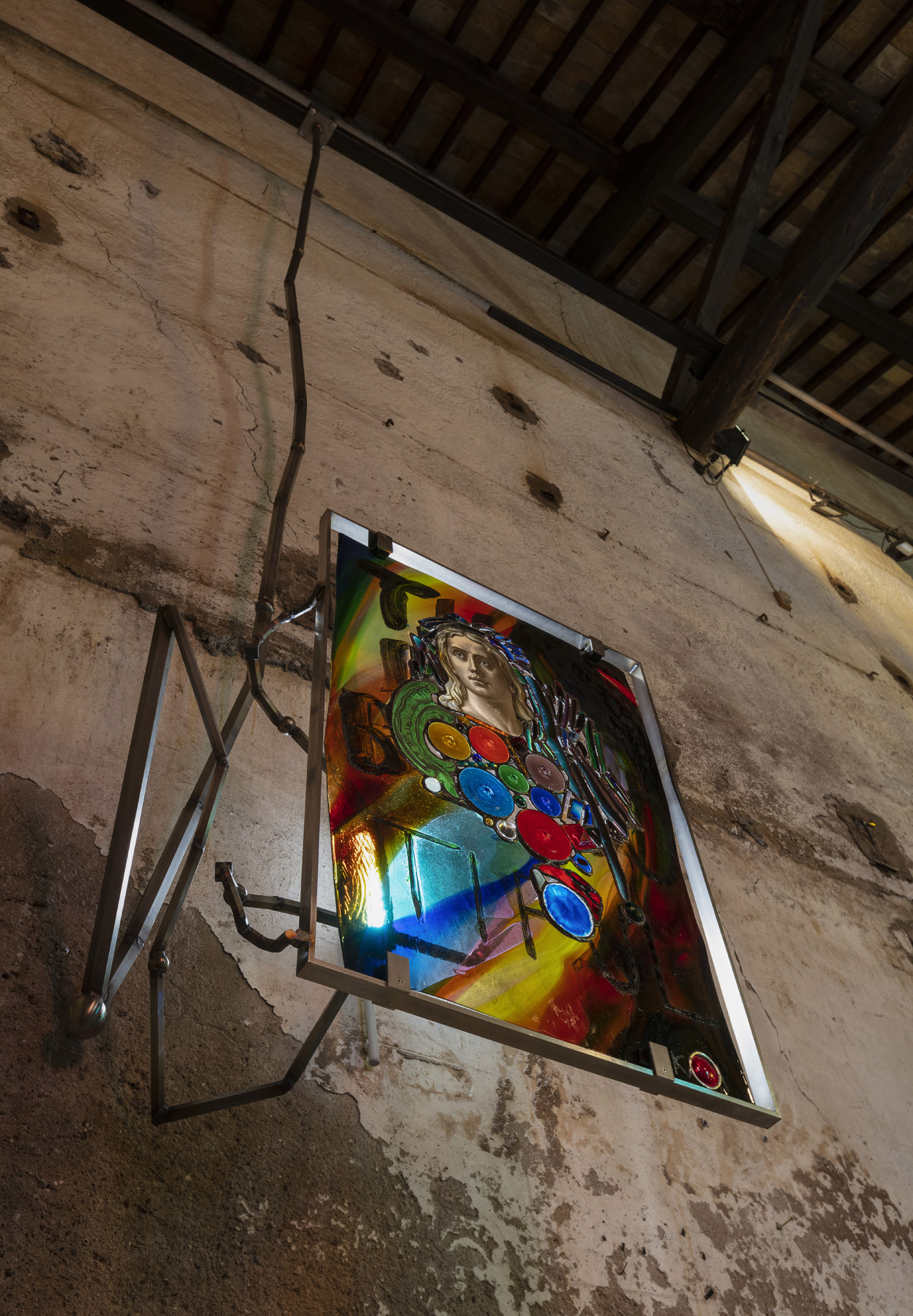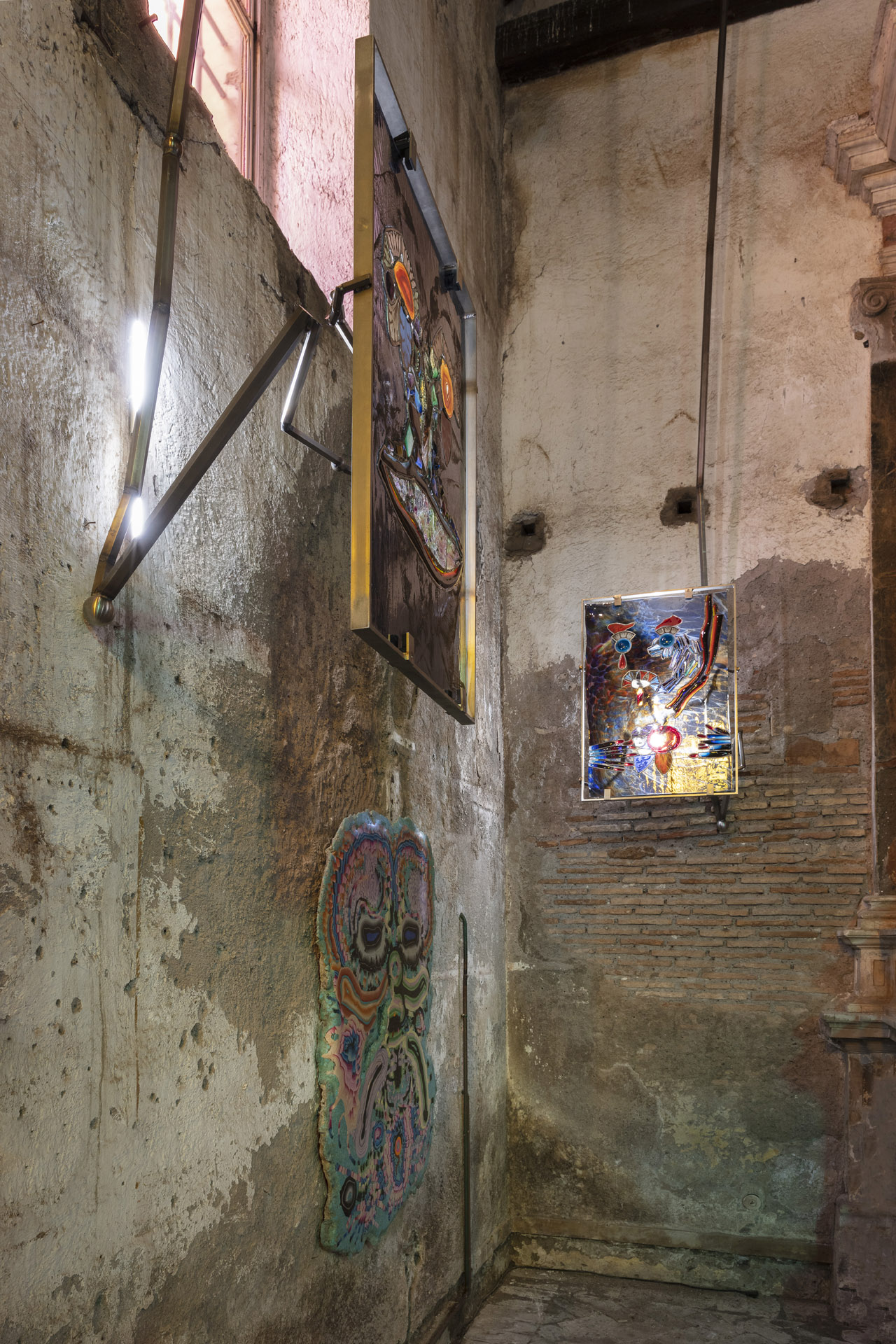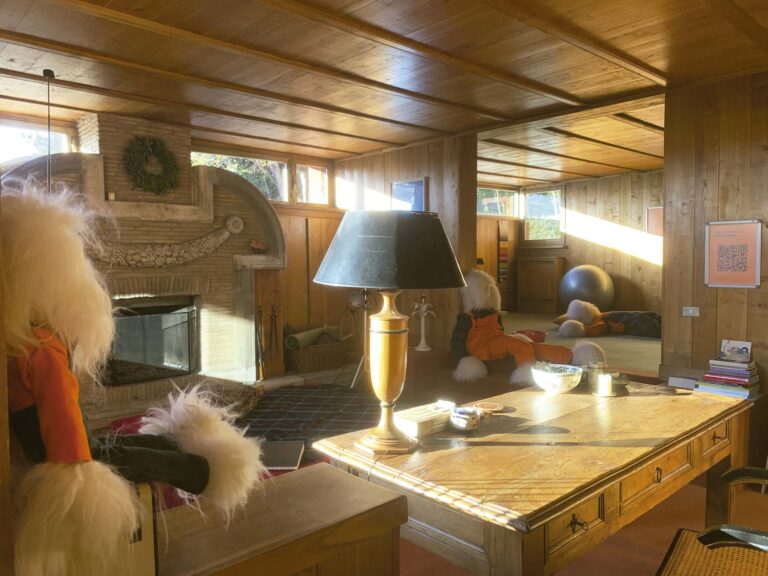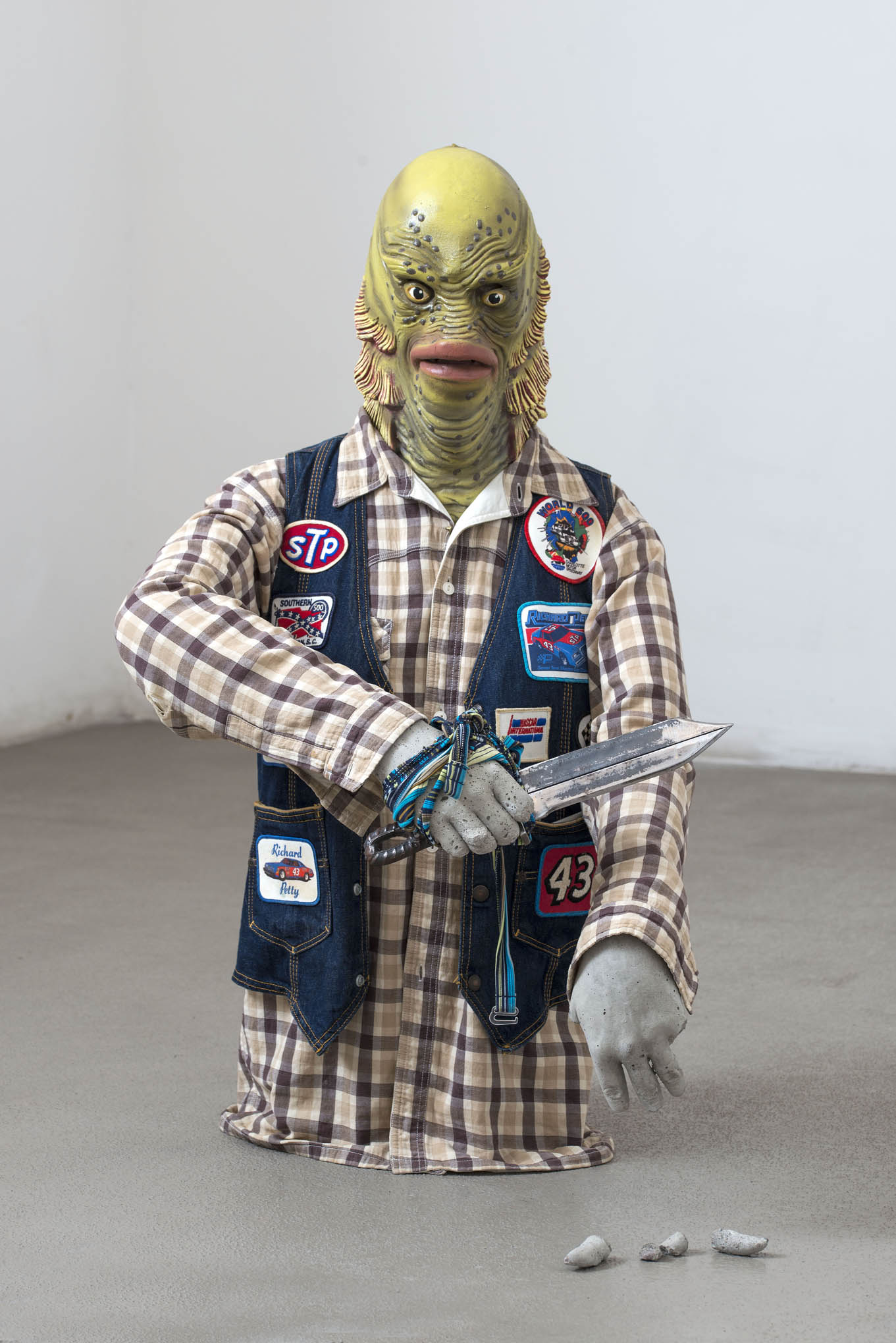Artists: Kerstin Brätsch and Eduardo Paolozzi
Exhibition title: Sun Swallower
Venue: Sant’Andrea de Scaphis, Rome, Italy
Date: June 30 – September 25, 2021
Photography: images copyright and courtesy of the artists and Sant’Andrea de Scaphis, Rome
The Spirit is everywhere. How then, does the spiritual imagination pass through material? According to writer Erik Davis, the ghost is always in the machine. In his 1998 book TechGnosis: Myth, Magic and Mysticism in the Age of Information, Davis charts how mysticism is bound up in the progress of technologies of communication, opposing Modernity’s disenchant-ment, and its ‘crisp, secular game plans of economic development, skeptical inquiry, and material prog-ress.’ Indeed, critic Lewis Mumford called this industrial image of technology the ‘myth of the machine’, and likewise, Davis suggests mythogenesis continues into an information age that’s all but otherwise been forsaken to rationalism.
The three metal sculptures in SUN SWALLOWER repre-sent Eduardo Paolozzi’s shift from casting in bronze to aluminum during the early 1960s. At the time, aluminum offered the artist, who was preoccupied with a renewed personal interest in Futurism, a relatively untouched material to work with; one that Mumford had attributed to the aptly descriptive ‘neotechnic’ – a term that could be considered a stage in evolutionary engineering, much like how the Neolithic describes the Stone Age. Writing on Paolozzi’s contribution to the sculptural field in 1964, art historian Herbert Read noted that ‘[…] his new images, functionless machine-tools, or sterile computers, derive not from the debris of industrialization, but from the rational order of technology… .’ Picking up on the artist’s usage of the word ‘idol’ in some of the titles of his work from this period, Read posited animist tendencies in his technical practice.
If Paolozzi ‘engineered’ his sculptures, then he did so in the spirit of the inventors Ctesibius and Philo of Byzantium who worked out of Alexandria when, as Davis has noted, ‘during its heyday’ the Egyptian city ‘was home to the makers.’ In the age of antiquity, Alexandria ‘resonates with our contemporary urban culture like no other city of the ancient world.’ Then came Heron, ‘the Machine Man’, whose ‘gadgets were wonderous rather than useful – magical machines that paradoxically eroded the cultural authority of the very rational know-how that stimulated their de-sign in the first place.’ Paolozzi’s The Twin Towers of the Sfinx – State II might suggest Egyptian architecture, but it also bears semblance to a cathedral, asoundsystem, or a kind of Hellenistic Wurlitzer. A shapeshifter then… Perhaps, in the deconsecrated space of Sant’ Andrea De Scaphis, it takes the place of the pipe organ – an instrument Ctesibius not only played but invented its precursor.
Where Paolozzi could be thought of as mechnikos then Kerstin Brätsch reimbues the medieval arts with gnostic ideas. Over the last ten years, she has worked with stained glass, melting down leftovers from church windows or shards from coats of arms in a continual, alchemical process encoding molten data from the past into the present. Suspended from the rafters by bespoke armatures resembling tech- insectoid limbs, the artist wanted ‘something alien and animatronic holding these ancient glassworks’ in this sanctum. Aside from stained glass’ obvious association within places of worship, titles such as Enki (Sohn), Nammu (Mutter), Hugin (Gedanke) and Muminn (Gedächtnis) (all 2012-21) nod to early civilizations, to mythos. Enki and Nammu are the names of Sumerian gods of wa-ter and knowledge. In Norse mythology, Huginn and Muninn are a pair of ravens that brought back news to Odin, whispering gossip into the All-Father’s ear. They were carriers of in- formation, like technology. And like water, knowledge flows.
Similarly, Brätsch’s works in stucco marmo are informational. They hover between the glyph, the rune, and the pictograph – forms of language that have crossed the sands of time. The artist refers to them as brushstrokes, a reminder that she speaks the language of painting. But what is such a gesture, if not magic? Like an inscription, cast into the air. If writ-ing is techne, ‘spelling is, in fact, a spell.’ Within the Church, the effigy to the Word made flesh, these fossilized spells illuminate the walls of a science-fictional archeological site: their radiant, occult textuality nurturing Paolozzi’s metal machines. Yet rather than eclipse one another, in this spiritual junkyard, to-gether, the ancient and the modern oscillate wildly.
Installation view: Kerstin Brätsch and Eduardo Paolozzi: Sun Swallower, at Sant’Andrea de Scaphis, Rome, 2021. Courtesy the artist and Sant’Andrea de Scaphis, Rome
Installation view: Kerstin Brätsch and Eduardo Paolozzi: Sun Swallower, at Sant’Andrea de Scaphis, Rome, 2021. Courtesy the artist and Sant’Andrea de Scaphis, Rome
Installation view: Kerstin Brätsch and Eduardo Paolozzi: Sun Swallower, at Sant’Andrea de Scaphis, Rome, 2021. Courtesy the artist and Sant’Andrea de Scaphis, Rome
Installation view: Kerstin Brätsch and Eduardo Paolozzi: Sun Swallower, at Sant’Andrea de Scaphis, Rome, 2021. Courtesy the artist and Sant’Andrea de Scaphis, Rome
Installation view: Kerstin Brätsch and Eduardo Paolozzi: Sun Swallower, at Sant’Andrea de Scaphis, Rome, 2021. Courtesy the artist and Sant’Andrea de Scaphis, Rome
Installation view: Kerstin Brätsch and Eduardo Paolozzi: Sun Swallower, at Sant’Andrea de Scaphis, Rome, 2021. Courtesy the artist and Sant’Andrea de Scaphis, Rome
Installation view: Kerstin Brätsch and Eduardo Paolozzi: Sun Swallower, at Sant’Andrea de Scaphis, Rome, 2021. Courtesy the artist and Sant’Andrea de Scaphis, Rome
Installation view: Kerstin Brätsch and Eduardo Paolozzi: Sun Swallower, at Sant’Andrea de Scaphis, Rome, 2021. Courtesy the artist and Sant’Andrea de Scaphis, Rome
Installation view: Kerstin Brätsch and Eduardo Paolozzi: Sun Swallower, at Sant’Andrea de Scaphis, Rome, 2021. Courtesy the artist and Sant’Andrea de Scaphis, Rome
Installation view: Kerstin Brätsch and Eduardo Paolozzi: Sun Swallower, at Sant’Andrea de Scaphis, Rome, 2021. Courtesy the artist and Sant’Andrea de Scaphis, Rome
Installation view: Kerstin Brätsch and Eduardo Paolozzi: Sun Swallower, at Sant’Andrea de Scaphis, Rome, 2021. Courtesy the artist and Sant’Andrea de Scaphis, Rome
Installation view: Kerstin Brätsch and Eduardo Paolozzi: Sun Swallower, at Sant’Andrea de Scaphis, Rome, 2021. Courtesy the artist and Sant’Andrea de Scaphis, Rome
Installation view: Kerstin Brätsch and Eduardo Paolozzi: Sun Swallower, at Sant’Andrea de Scaphis, Rome, 2021. Courtesy the artist and Sant’Andrea de Scaphis, Rome
Installation view: Kerstin Brätsch and Eduardo Paolozzi: Sun Swallower, at Sant’Andrea de Scaphis, Rome, 2021. Courtesy the artist and Sant’Andrea de Scaphis, Rome
Installation view: Kerstin Brätsch and Eduardo Paolozzi: Sun Swallower, at Sant’Andrea de Scaphis, Rome, 2021. Courtesy the artist and Sant’Andrea de Scaphis, Rome
Installation view: Kerstin Brätsch and Eduardo Paolozzi: Sun Swallower, at Sant’Andrea de Scaphis, Rome, 2021. Courtesy the artist and Sant’Andrea de Scaphis, Rome
Installation view: Kerstin Brätsch and Eduardo Paolozzi: Sun Swallower, at Sant’Andrea de Scaphis, Rome, 2021. Courtesy the artist and Sant’Andrea de Scaphis, Rome
Installation view: Kerstin Brätsch and Eduardo Paolozzi: Sun Swallower, at Sant’Andrea de Scaphis, Rome, 2021. Courtesy the artist and Sant’Andrea de Scaphis, Rome
Installation view: Kerstin Brätsch and Eduardo Paolozzi: Sun Swallower, at Sant’Andrea de Scaphis, Rome, 2021. Courtesy the artist and Sant’Andrea de Scaphis, Rome

























